Back to Adelaide Supanova, this time a truly epic interview! We joined Man of Action Studio in their booth for a long interview about the creation of Ben 10, the haters of Ultimate Spider-Man and their dream projects.
If you want to hear the interview, complete with background convention noise, the MP3 is at the bottom of the page.
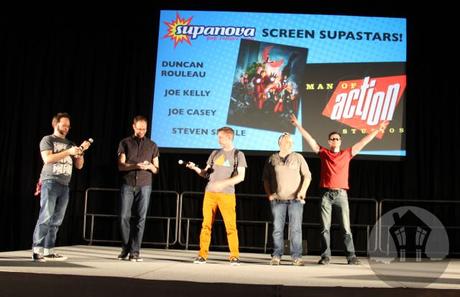
The Men of Man of Action take to the stage for the opening night.
G-Funk: We are on the floor at the Adelaide Supanova convention currently talking to the men of Man of Action studio. We’ll be talking to them one at a time. Could you please tell us who you are and what your role is in the studio?
Joe Casey: Joe Casey, Supreme Instigator.
G: Instigator? So you got this whole shebang going?
JC: Well no, I instigate as we go along.
G: I did hear a good story about how you started out…it was all to do with sitting down?
JC: Well, yes, that is part of the legend. At the San Deigo Comic Con it’s nice when you have a place to sit and the best way to get that is to have a company so you can have a booth and a table and a place to sit…that was definitely one of the motivators. Made it seem like a good idea at the time.
G: You’re sitting down now – is it everything you ever hoped for?
JC: We have better booth placement! As the years have rolled on we’ve gotten better positioning on the floor so it’s worked out!
G: Most companies start small and build up, but you had a hit out of the gate, didn’t you?
JC: No, we did a couple of little things. One of the first things we as a company did was the writing the X-Men Legends video game for Activision. That was a big deal at the time. Not a lot of comic book writers had made those transitions over to other media. From there, that legitimised the company to some extent. The credit went out as written by Man of Action – it was the first one that had that credit – and then it kinda built from there. The Ben 10 thing happened because – coming from comics – we’d talked a lot to Wizard Magazine, which is a big comic magazine at the time, and one of the editors there was Matt Senreich who then went on to create Robot Chicken with Seth Green. They had asked Matt at Cartoon Network if he knew anyone who could come in and pitch original superhero ideas. He recommended us and we went in and pitched Ben 10 and the rest is history.
G: Just how big did Ben 10 get?
JC: Well they tell me now that it’s a 3 billion dollar global juggernaut. They don’t use the word ‘juggernaut’, that was me. But 3 billion is a lot and it has gone all around the word. We were just happy at the beginning to get a show on the air. We thought ‘this is neat’ and another line on our resume doing an animation show. It fit with the kind of company we were and it fit with our brand and then it blew up bigger than…Cartoon Network didn’t expect it to blow up like it did. It’s good times.
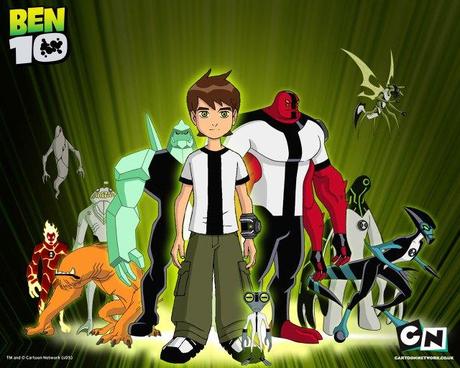
G: Now you have the biggest Cartoon Network in history – what did that lead into?
JC: From there it opened up a whole new avenue of work for us. People started coming to us to do animated projects. We consulted on a show called Bukagan, which also ran on Cartoon Network. Then we were tapped by Marvel to rewrite a couple of episodes of Avengers: Earth’s Mightiest Heroes. We signed on to produce and run the writing on Ultimate Spider-Man and then from there: Avengers Assemble.
G: You’ve got a couple of big names under your belt – if you had complete choice to do any animated series you want, what would it be?
JC: Probably something…we’re kinda it doing it already. From there we’ve grown into doing some co-productions with some foreign animation studios because of the global nature of Ben 10. The recognition is such that we work with animation studios in Korea, France, all over the place. We have a lot more control over those. In a sense it has lead to what we really want to do which is create something from the ground up, see it through to completion, have some control over it and own a piece of it. So everything…it’s sought of like the best of all the possible worlds so far has started to come to fruition.
G: When you look up Ultimate Spider-Man online it’s a real love it or hate it attitude. Do you have a response to that?
JC: It’s a show that’s designed for kids and it’s based on a character that, at this point, is very multigenerational. A lot of guys my age still love Spider-Man, still read the comics and if there’s an animated show on about Spider-Man, odds are they’ll check it out. But our mandate from the very beginning was because comics skew a little older now – they just do: the people who make them, the people who read them, we’re going for a more sophisticated audience – that in a way has edged out a lot of kids. A kid reading a modern Spider-Man comic, a six year old, say, it might be a little over their heads. The quality of writing and the quality of the art is so high that the content kind of matches that. The median age for comic books is maybe twenty to twenty-five, maybe even thirty years old, and we have research that tells us that.
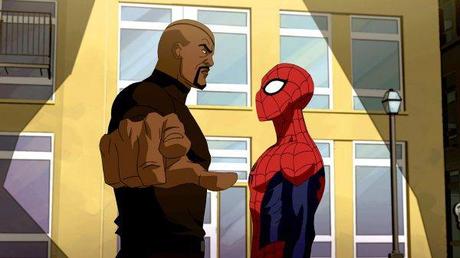
We were real concerned, and Marvel was concerned, that young kids weren’t getting into Spider-Man early enough. Even the movies tend to skew a little older because there’s a level of violence in them, there’s a level of action, that maybe young kids – 5, 6, 7 years old – might not be able to see. Marvel wanted a Spider-Man entry point and that’s where the humor comes in, that the type of stories that we tell and the types of storytelling we of come from. So when you’re geared to a young audience specifically it tends to sometimes edge out the older audience. If they don’t know or they don’t assume that it’s a show for young kids they’re going to get upset about it because it’s not speaking to them as much as they would like. I totally get that but in the greater scheme of things it’s more important to get those kids involved and get them interested in the characters and the Marvel universe, then they can graduate to the comic books – which is really where we really want them to go. We love comic books so we want the readers there. It’s hard for kids to get comic books, it’s hard for them to hook into them now. They’re not always going to comic book stores. The cartoon we’re hoping is a good way to just get them introduced to the Marvel universe and Spider-Man in particular. And it’s worked – people who didn’t know about the character, kids and little kids we see at conventions like this are like ‘we love Spider-Man’.
G: Including my 3 year old.
JC: That’s great! Hopefully, we’re hoping that you’re hoping that he’ll grow up and he’ll know that there’s a bunch of Spider-Man comics out there from the old Stan Lee and Steve Ditko stuff up to the stuff they’re doing now that he can plug right into when he’s old enough to really appreciate them.
G: That’s the plan.
SuperMarcey: In the early days what are the toughest challenges you have to overcome in order to get your products out there?
JC: Do you mean as the company or as individuals…?
SM: As a company, just starting out, because obviously it’s going to be tough?
JC: As a company we’d all come from comic books individually. So, for instance, working on the X-Men game for Activision that came from the fact that I was writing the X-Men comic. So taking the first initial steps forward as a company was all about familiar brands that they wanted us to come in and work on. It wasn’t until Ben 10 that we could point to something and say ‘we made it up, we created it’ and luckily it was successful so that helped. Had not been successful, if it had just come on the air, come and gone like most TV shows do we’d have just kept plugging away, plugging ourselves into other people’s shows, so we were very lucky to have that success very early on.

G: We’ll let you get back to your fans here, they’re looking pretty keen and we’ll chat with some of your colleagues. Thank you Joe Casey!
G: Whom am I talking to here from Man of Action?
Joe Kelly: I’m Joe Kelly, how are ya?
G: Hello Joe, what’s your role with the Man of Action studio?
JK: Brains and brawn.
G: Brains and brawn? I think I need some more information…
JK: Well, I’m one of the co-founders, I’m a writer, we write and produce Ultimate Spider-Man, Avengers Assemble and we created Ben 10 and all those wonderful things. We also write comics and do cartoons.
G: Joe (Casey) told us a lot about Ben 10, so: Ultimate Spider-Man: quite different from the comics. What were we shooting for?
JK: I think I heard Joe say what Joe Quesada said to us in the room, ‘you’re introducing Spider-Man to a whole new audience so pretend nothing has ever come before. How do you introduce this concept to a kid?’ So we took what we loved about comics as we remember them. Stan’s (Lee) captions, the thought balloons and the direct contact with the audience. But how do you animate that? It’s boring if you just have a voice over. We started breaking the fourth wall and that’s what clicked it for us, that’s what made the show unique from all the other Spider-Man shows.
G: There’s a few people who are not big fans of the show…
JK: They’re wrong.
G: They’re wrong? Is that all we get?
JK: No, you know, we’ve been really lucky. In the beginning people saw stuff even before the show came out. We had a lot of internet haters and then over the course of the last couple of San Diego’s (Comic Cons) we’ve had a lot of people come up and say ‘yeah, I wasn’t sure at first but now I kinda like it’, like they dig it. Especially the parents who can watch it with their kids and actually find the humor in it that their kids might not get. It’s been a great turn around.
G: My son is a big fan of it. Do you feel like you’ve got the audience you wanted?
JK: For sure, yeah. We’re having a good time with it. We feel that with all our shows we never write down to the audience, we always write up to it. If that means we get some adults into the mix as well on a kids show – great, but we know who our target is and we’re happy to aim in that direction.
G: If you had a dream project, what would it be?
JK: We’re very, very lucky, we’re working on all our dream projects. Our comics that we publish through Image are all the ones we want to do, we’re given carte blanche to do pretty much what we want. Working on a mainstream character – Spider-Man was my favorite growing up so I’ve already done it. My next dream project is whatever our next project is going to be.
G: That’s a good life!
JK: Yeah, we’re very lucky and very appreciative.
G: Thanks for talking to us, we’re going to move down the line and talk to the rest of the studio.
JK: Thank you very much!
G: Whom do we have here?
Steven Seagle: Steve Seagle.
G: And what’s your role at Man of Action?
SS: I’m just the beauty.
JK: (In background) It’s true.
G: That was going to be my first guess.
SS: We’re all equal partners in Man of Action, the four of us. We kinda do the same things. We make up cool stuff in animation, live action and comic books.
G: Do you prefer the animation or the comics?
SS: Each thing has its own appeal. You’ve got to find out what you like about what you’re doing. With animation we can do anything we want, there’s no budget there’s no rules in terms of what you can show or can’t show. With animation you can just make it happen. With comic books we can all express ourselves individually. With the live action stuff coming up it’s getting to work with living, breathing people. That’s kinda fun.
G: Tell us about the live action, what have you got coming up?
SS: We have two TV series’ and three feature films, some of it announced, some haven’t. The ones that have been announced are Duncan’s film Great Unknown, which he can tell you about in a minute, based on his comic book put out by Image. There’s Kafka, which is a book I did years ago with Stefano Gaudiano and it’s in developed for television at the moment with Kenneth Branagh.
G: Is that everything that’s announced or some of the unannounced?
SS: That’s everything that’s announced. Unfortunately we can’t announce the unannounced.
G: Small hint?
SS: Can’t do it!
SuperMarcey: Briefly before you mentioned the books for children. Tell us how that happened and what you’ve got out.
SS: Sure. We do a lot of cartoons for mostly kids but people of all ages of course. Our comics tend to be for adult readers, like a PG or R rating movie mostly, and year after year people come up and ask what comics they can get from for their kids and I have to say ‘none of them!’ So now I’m doing a kids book once a year with Marco Cinello, an artist on the Spongerbob movie. We’re doing new twists on classic monsters. We’ve done Frankie-stein, which about a little boy who runs away to prove that he isn’t a monster but he runs away on Hallowe’en and finds that everyone is a monster in one way or another. There’s Batula about Livingstone, a little fruit bat, who gets bitten by a vampire and turns into a vampire bat and then has to decide if that’s a bad thing or a good thing.
G: I think I want to buy Batula.
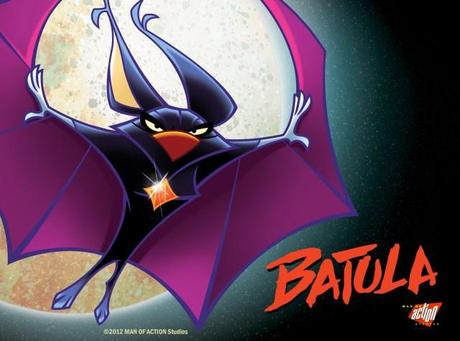
I totally did.
SS: (Laughs) I hope so! I have exactly one copy to sell here in Australia.
G: Can I bags it?
SS: Absolutely. They’re also available on Amazon and it comes through Image and comic shops have them.
G: So are you saying that American Virgin is not for kids?
SS: It is not for kids! But we have some exciting American Virgin news coming up next year.
G: Good luck with all your projects and the rest of the weekend! We’ll have a chat with Duncan next.
SS: Thanks so much, nice talking to you!
G: G’day Duncan – can you tell us who you are and what you do with Man of Action?
Duncan Rouleau: My name is Duncan Rouleau, I’m one of the partners in Man of Action. I draw and write comic books and also animation. I’m one of the equal four partners inside the company.
G: Man of Action has been going on the up and up with many good titles. What would you say is your biggest point of pride?
DR: I suppose the biggest point of pride would ultimately be, we’ve gotten to the place inside of comic books where we can publish anything we want and they’ll be little bit of audience for it and that validates us as…I know it validates me…as an artist. I love that sense of freedom that we’ve gotten so that’s the part that I’m most proud of. I’ve gotten to that place when where I don’t have to do those things, I do them because I want to.
G: I’m sorry but the rest of the crew got the easy questions so we’re going to hit you with the hard ones.
DR: Uh oh.
G: Do you feel like you’ve gotten out from under the control of the big studios?
DR: In a way, yes. What we do now, and I often joke but I think it’s true, we don’t work for Marvel right now, we work with Marvel. They really give us a lot of leeway, they trust us. Much to the credit of the guys who are in charge right now, Jeph Loeb and Joe Quesada, are both artists and writers themselves and we’ve known them for years. When we work with them it’s very collaborative. There’s a lot of mutual respect going on. It’s been very pleasurable and ultimately we don’t have to do that job if we don’t want to. We LIKE doing that job because they’re our buds. Yeah, that’s the long and short of it, and it makes it all worthwhile.
G: Between Ben 10 and Ultimate Spider-Man you’re pretty much free to pick and choose projects. What would be your dream project?
DR: Ah. Well, the standard answer and the truth it’s always whatever project you’re working on right now. I get very excited by those notions. You know, in a weird way we kinda got what we wanted which is ‘I kinda feel like doing this’ and we put our efforts towards that. And really we’re in that sweet spot right now – I don’t know how long that will last, mind you – but right now we are and it’s wonderful. In a weird way my dream project is doing Man of Action and it allows us that freedom.
G: And the freedom to sit down at cons.

Sitting down and meeting their eager fans.
DR: That’s right! Well, in Australia as opposed to Kansas City!
G: It’s not bad here. I should point out that while we’re talking you’ve been drawing the hell out of Captain America. Do you do a lot of illustrations for people coming through for autographs?
DR: That was my beginnings, in comic books, and I’ve gotten to draw most of my favourites as a kid. Him being one of my personal faves, so I think I always give him some extra love. Yes, I draw an awful lot of characters. But now I spend a great deal more time, and this is something we often say with Man of Action, one of our favorite things about working on our own comic books was that we want to be like the guys who first put together Marvel and DC. They were pioneers, they were making up something new. Right now with those publishers you’re carrying a torch. You had all these great artists coming before you and you want to make sure that you don’t screw up. Here you go…(Duncan has finished the drawing and handing it over to a girl dressed as a Rebel Alliance pilot)
G: Tell us what you think?
Fan: It’s really amazing!
G: It’s really amazing. Are the cons good fun?
DR: Yes! Everyone has been fantastic! (Duncan begins work on a picture of Wolverine for another fan).
G: We’ll let you get back to your sketches, and I’ll come by to get one for myself later!
I’ll say this for the Man of Action crew – it’s nothing short of admirable they way they spent their weekend creating personal works for every young fan to come to their table. We love seeing the artists and fans able to come together like this!
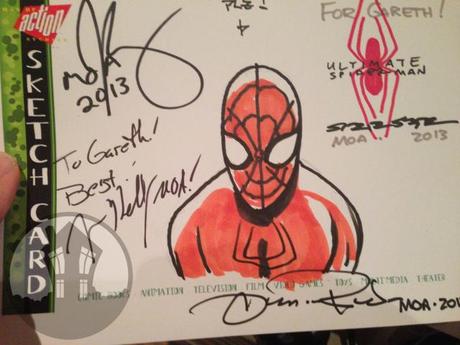
I totally did.
Listen to it here!

